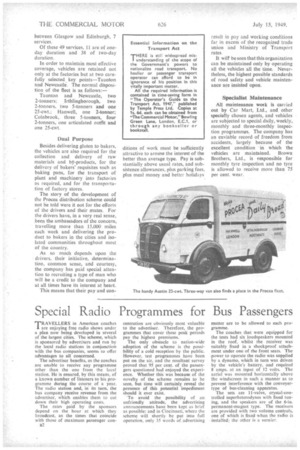Special Radio Programmes for Bus Passengers
Page 12

If you've noticed an error in this article please click here to report it so we can fix it.
TRAVELLERS in American coaches I are enjoying free radio shows under a plan now being developed in several of the largest cities. The scheme, which is sponsored by advertisers and run by the local radio stations in conjunction with the bus companies, seems to offer advantages to all concerned.
The advertiser benefits, as the coaches are unable to receive any programme other than the one from the local station. He is ensured. by this means, of a known number of listeners to his programme during the course of a year. The radio station and, in its turn, the bus company receive revenue from the advertiser, which enables them to cut down their high operating costs.
The rates paid by the sponsors depend on the hour at which they broadcast, as the times that coincide with those of maximum passenger con
Et2 centration are obviously most valuable to the advertiser. Therefore, the programmes that cover these peak periods pay the highest premiums.
The only obstacle to nation-wide adoption of the scheme is the possibility of a cold reception by the public. However, test programmes have been put on the air, and the resultant survey proved that 95 per cent. of the passengers questioned had enjoyed the experience. Whether this was because of the novelty of the scheme remains to be seen, but time will certainly reveal the presence of this potential impediment should it ever exist To avoid the possibility of an unfriendly attitude, the advertising announcements have been kept as brief
• as possible; and in Cincinnati, where the scheme will shortly be put into full operation, only 35 words of.advertising matter are to be allowed to each programme.
The coaches that were equipped for the tests had six loudspeakers mounted in the roof, whilst the receiver was suitably fixed in a shockproof attachment under one of the front seats. The .power to operate the radio was supplied by a dynamo, which in turn was driven by the vehicle's battery, and required 8 amps. at an input of 12 volts. The aerial was mounted horizontally above the windscreen in such a manner as to prevent interference with the conveyertype of bus-cleaning apparatus.
The sets are 11-valve, crystal-controlled superheterodynes with fixed tuning, and the speakers are of the 6-iu. permanent-magnet type. The receivers are provided with two volume controls, one of which is fixed when the radio is installed; the other is a vernier.


























